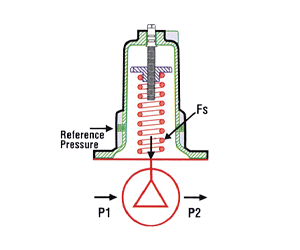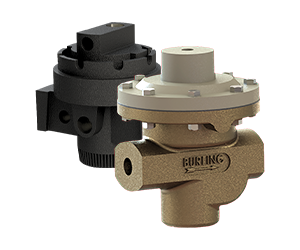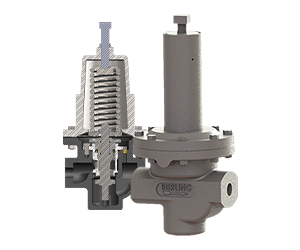Pressure Reducing Regulators
Pressure reducing regulators accept an inlet pressure (P1) and reduce this inlet pressure to a specific output (P2) pressure. These regulators can be configured to control the pressure of various gases and liquids accurately and repeatably. From self-venting general purpose regulators to miniature safety regulators, specialty regulators for sensitive or high pressure (5000+ psi) applications, we have a product to meet your needs.
Have a robust industrial application? Our Burling Valve line ranges in sizes from 1/2″-4″ bodies and 6″ or 8″ flange mount. These pressure reducing regulators are available in spring-loaded, dome-loaded and differential models, including a mechanically piloted dome-loaded version.

Differential Pressure Reducing Regulators
Positive and negative differential and negative bias available.Learn MoreFrequently Asked Questions
Our pressure reducing regulators are designed to maintain a consistent downstream pressure regardless of variations in upstream pressure or flow. Key features include high accuracy, rapid response time, and the ability to handle a wide range of flow rates. They also offer modular designs for easy integration into various systems and are available in different sizes and pressure ranges to accommodate diverse applications. Our dome-loaded options are ideal partners for our electro-pneumatic regulators to pilot.
By maintaining a consistent and controlled downstream pressure, our pressure reducing regulators prevent fluctuations that can lead to inefficiencies or system damage. This consistency helps optimize the performance of equipment, reduces energy consumption, and prolongs the lifespan of downstream components by preventing pressure surges.
Yes, we offer pressure reducing regulators capable of handling high-pressure applications. The regulators are engineered to provide outlet pressures up to 5000 psi, making them suitable for demanding industrial environments. Ratio regulator options are available for applications requiring even higher pressure thresholds.
Our pressure reducing regulators are constructed using high-quality materials such as stainless steel, brass, and aluminum, which provide excellent corrosion resistance and durability in harsh environments. The choice of materials ensures long-lasting performance, even in challenging conditions, reducing the need for frequent maintenance or replacements.
Our pressure reducing regulators are designed to automatically adjust the flow rate to maintain a consistent downstream pressure, even when upstream pressure fluctuates. This dynamic response is achieved through a balanced valve design and precision control mechanisms, ensuring stable performance and protecting downstream equipment from pressure spikes.
Yes, we offer pressure reducing regulators that are specifically designed to handle corrosive gasses or liquids. These regulators are made from corrosion-resistant materials such as stainless steel and have specialized seals to prevent leakage and degradation, making them ideal for use in chemical processing or other industries where corrosive substances are present.
Maintenance for our pressure reducing regulators is minimal, thanks to their robust design and high-quality materials. Regular inspection and cleaning of the regulator’s components, such as the valve and seals, are recommended to ensure optimal performance. Detailed maintenance guidelines are provided in the product manuals, and we offer support for troubleshooting, repairs or part replacements, including repair kits.
Selecting the right pressure reducing regulator involves considering factors such as the required downstream pressure, the flow rate, the type of gas or liquid being regulated, and the operating environment. We provide detailed specifications and guidance on each product’s page to help customers choose the appropriate regulator. Additionally, our applications team is available to assist with product selection and customization options.
Installation of our pressure reducing regulators is straightforward but must be done correctly to ensure proper operation. The regulator should be installed in a location that is easily accessible for maintenance and free from excessive vibration or temperature extremes. It is important to follow the installation instructions provided in the installation manual, which include proper orientation, securing connections, and ensuring that all components are compatible with the regulator.
Yes, our pressure reducing regulators can be integrated with various control systems. They are compatible with both pneumatic and electronic control systems, allowing for precise regulation and monitoring of pressure in real-time. We offer customization options to ensure seamless integration with existing systems, enhancing overall system automation and control.


